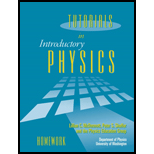
A capacitor is connected to a battery, bulb, and switch as shown. Assume that the switch has been closed for an extended period of time.

1. Predict whether the brightness of the bulb is the same as, greater than, or less than the brightness of a single bulb connected to a battery. Explain.
2. Predict how the potential difference across the battery to the potential differences across the capacitor plates and to the potential difference across the bulb. Explain.
3. Briefly describe the distribution of charge, if any, on the capacitor plates.
Recall the relationship between the charge on a capacitor and the potential difference across the capacitor. Use this relationship to describe how you could use a voltmeter to determine the charge on a capacitor.
4. Obtain the circuit and a voltmeter. Check your predictions for parts 1 and 2.
(1)
To Explain:Whether the brightness of the bulb is the same as, greater than or less than the brightness of a single bulb connected to a battery.
Answer to Problem 1aT
Brightness of the bulb changes with the time in RC circuit but it is constant in case of battery only.
Explanation of Solution
Introduction:
Ohm’s Law: The current in the circuit is directly proportional to the potential difference and the constant of proportionality is known as resistance R.
The potential difference across the capacitor is given as:
Where,
A RC circuit with a battery connected to the capacitor through a Bulb with a resistance of
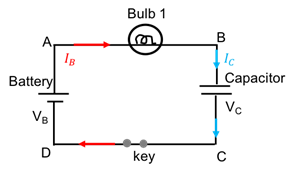
Figure 1: A RC circuit with a battery, bulb and a capacitor
After a long time, the circuit will behave as an open circuit and Therefore, current in the circuit drops to zero with the time till the capacitor voltage equals to the battery voltage.During initial moment, the brightness of the bulb in this RC is equivalent to the single bulb with the battery.But as the time passes, current starts dropping, hence, brightness decreases till the circuit becomes open due to the charging of the capacitor.
Conclusion:
Brightness of the bulb changes with the time in RC circuit but it is constant in case of battery only.
(2)
To Compare: The potential difference across capacitor, bulb and battery.
Answer to Problem 1aT
The voltage difference between the terminals of the battery is
Explanation of Solution
Introduction:
Ohm’s Law: The current in the circuit is directly proportional to the potential difference and the constant of proportionality is known as resistance R.
The potential difference across the capacitor is given as:
Where
A RC circuit with a battery connected to the capacitor through a Bulb with a resistance of
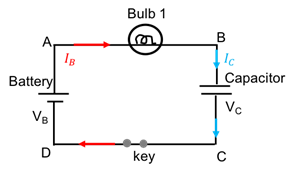
Figure 2: A RC circuit with a battery, bulb and a capacitor
The voltage difference between the terminals of the battery is
Hence, the voltage through the loop can be written as:
Conclusion:
The voltage difference between the terminals of the battery is
(3)
Charge distribution on the plates of the capacitor.
Answer to Problem 1aT
One of the plates accumulates positive and other negative charge in equal magnitude.
Explanation of Solution
Introduction:
The charge on the capacitor is directly proportional to the potential difference across the capacitor plates,
Where ‘C’ is the constant known as the capacitance which depends on the material and design property of the capacitor.
In given circuit, shown in Figure 3, the positive terminal of the battery is connected with the upper plate of the capacitor and the lower one with negative terminal of the battery.
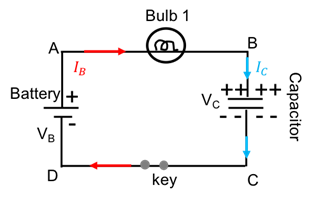
Figure 3: Charge distribution on the capacitor
Current flows from positive terminal of the battery to towards the bulb. Basically, current is in the opposite direction of the flow of the electrons. Electrons from the upper plate of the capacitor starts moving towards positive terminal of the battery and leaves the upper plate positive and electrons in the lower plate are repelled from the negative terminal of the battery. This accumulation of the charge happens till the potential difference across the plate is equal to the battery voltage. Also, the charge on the plates is equal in magnitude and opposite in charge.
Conclusion:
Hence, one of the plates of the capacitor accumulates positive and other negative charge in equal magnitude.
(4)
To Check: The predictions using voltmeter in the circuit.
Explanation of Solution
Introduction:
Ohm’s Law: The current in the circuit is directly proportional to the potential difference and the constant of proportionality is known as resistance R.
The charge on the capacitor is directly proportional to the potential difference across the capacitor plates,
Where ‘C’ is the constant known as the capacitance which depends on the material and design property of the capacitor.
In given circuit, shown in Figure 4, voltmeters are connected parallel to the battery, bulb and the capacitor in order to observe the potential for each circuit element after capacitor is fully charged. Once the capacitor is fully charged, circuit becomes open circuit and hence, no current flows through the circuit.
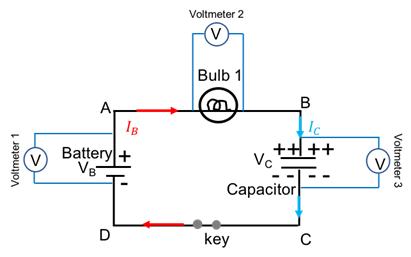
Figure 3: Circuit to calculate Vpotential across battery, bulb and the capacitor
Let say the battery has a
After a long time,the battery voltage is dropped cross the capacitor andpotential across the capacitor is calculated as 5 V and the voltmeter 3 reads 5 V.
Potential across the bulb, and the voltmeter 2 reads 0 V.
Voltmeter 1 reads 5 V.
Charge on the capacitor will be:
Conclusion:
Hence, potential across the battery and the capacitor is 5 V and the bulb is 0 V. Charge on the capacitor is
Want to see more full solutions like this?
Chapter 6 Solutions
Tutorials In Introductory Physics: Homework
Additional Science Textbook Solutions
Chemistry: Structure and Properties (2nd Edition)
College Physics: A Strategic Approach (3rd Edition)
Genetic Analysis: An Integrated Approach (3rd Edition)
Applications and Investigations in Earth Science (9th Edition)
Biology: Life on Earth (11th Edition)
Chemistry: An Introduction to General, Organic, and Biological Chemistry (13th Edition)
- pls help on all asked questions kindlyarrow_forward19. Mount Everest, Earth's highest mountain above sea level, has a peak of 8849 m above sea level. Assume that sea level defines the height of Earth's surface. (re = 6.38 × 106 m, ME = 5.98 × 1024 kg, G = 6.67 × 10 -11 Nm²/kg²) a. Calculate the strength of Earth's gravitational field at a point at the peak of Mount Everest. b. What is the ratio of the strength of Earth's gravitational field at a point 644416m below the surface of the Earth to a point at the top of Mount Everest? C. A tourist watching the sunrise on top of Mount Everest observes a satellite orbiting Earth at an altitude 3580 km above his position. Determine the speed of the satellite.arrow_forwardpls help on allarrow_forward
- pls help on allarrow_forward6. As the distance between two charges decreases, the magnitude of the electric potential energy of the two-charge system: a) Always increases b) Always decreases c) Increases if the charges have the same sign, decreases if they have the opposite signs d) Increases if the charges have the opposite sign, decreases if they have the same sign 7. To analyze the motion of an elastic collision between two charged particles we use conservation of & a) Energy, Velocity b) Momentum, Force c) Mass, Momentum d) Energy, Momentum e) Kinetic Energy, Potential Energyarrow_forwardpls help on all asked questions kindlyarrow_forward
- pls help on all asked questions kindlyarrow_forward17. Two charges, one of charge +2.5 × 10-5 C and the other of charge +3.7 × 10-6 C, are 25.0 cm apart. The +2.5 × 10−5 C charge is to the left of the +3.7 × 10−6 C charge. a. Draw a diagram showing the point charges and label a point Y that is 20.0 cm to the left of the +3.7 × 10-6 C charge, on the line connecting the charges. (Field lines do not need to be drawn.) b. Calculate the net electric field at point Y.arrow_forward3arrow_forward

 Physics for Scientists and Engineers, Technology ...PhysicsISBN:9781305116399Author:Raymond A. Serway, John W. JewettPublisher:Cengage Learning
Physics for Scientists and Engineers, Technology ...PhysicsISBN:9781305116399Author:Raymond A. Serway, John W. JewettPublisher:Cengage Learning Glencoe Physics: Principles and Problems, Student...PhysicsISBN:9780078807213Author:Paul W. ZitzewitzPublisher:Glencoe/McGraw-Hill
Glencoe Physics: Principles and Problems, Student...PhysicsISBN:9780078807213Author:Paul W. ZitzewitzPublisher:Glencoe/McGraw-Hill
 College PhysicsPhysicsISBN:9781938168000Author:Paul Peter Urone, Roger HinrichsPublisher:OpenStax College
College PhysicsPhysicsISBN:9781938168000Author:Paul Peter Urone, Roger HinrichsPublisher:OpenStax College Physics for Scientists and EngineersPhysicsISBN:9781337553278Author:Raymond A. Serway, John W. JewettPublisher:Cengage Learning
Physics for Scientists and EngineersPhysicsISBN:9781337553278Author:Raymond A. Serway, John W. JewettPublisher:Cengage Learning





